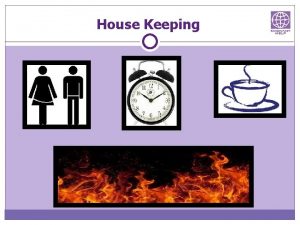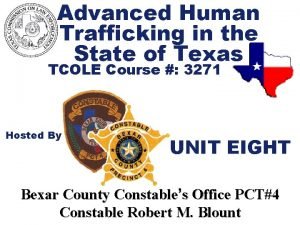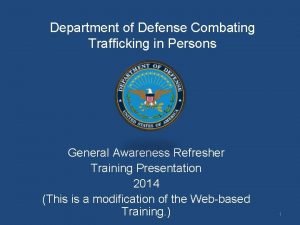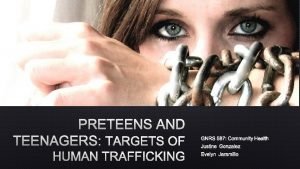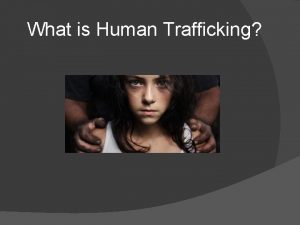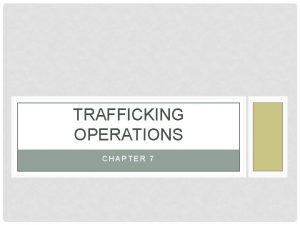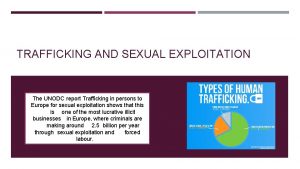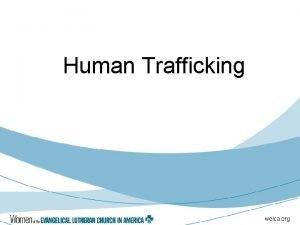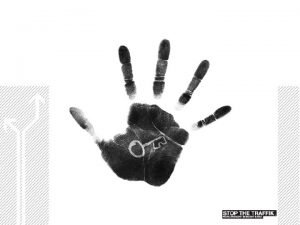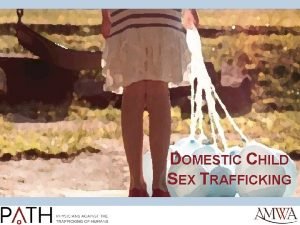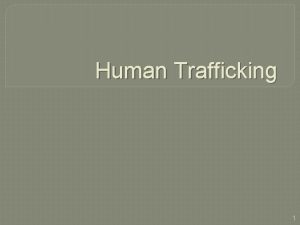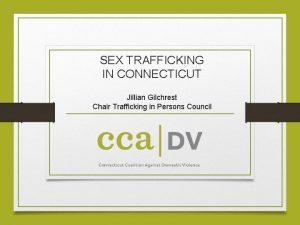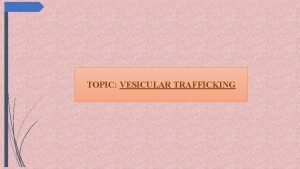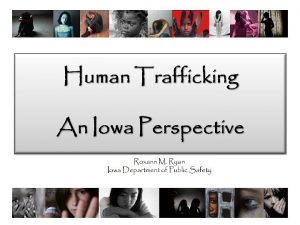Psychology of Trafficking and the Services Required Understanding
































































- Slides: 64

Psychology of Trafficking and the Services Required Understanding victims must precede service provision

Disclaimer • The information provided in this presentation is designed for educational purposes only • Completion of this presentation does not prepare the viewer to work with victims of human trafficking without further training • In the event that human trafficking is suspected, contact the National Hotline at 888 -3737 -888 (c) 2015 LACAT 2

Victim selection • Pimps and recruiters seek out the vulnerable; people who are looking to fill some gap in their lives • Not restricted by race, socio-economic status, education or geographical location • Every person who lacks a sense of selffulfillment is vulnerable to traffickers (c) 2015 LACAT 3

Keep in mind… • Average of entrance into human trafficking is 11 -14 • Most victims have a history of domestic violence or abuse • Most victims are seeking family of some sort • Victims are being sold a dream by very persuasive people (c) 2015 LACAT 4

Victim presentation • Victims seldom self-identify • Part of the grooming process teaches them that they are willing participants • Normalization of commercial sex activities • Erotic music videos > soft porn > hard porn > sex with pimp > sex with others • Fear – threats of harm to loved ones • Violence is a very real ingredient in The Life • Many victims act and claim that The Life is their choice and that they don’t want or need help (c) 2015 LACAT 5

Victim presentation cont. • Drug use/addictions • Often forced but normally claim it’s by choice • Used by pimps to manipulate their victims • Shame and blame • Trauma-bonding leads them to believe they are not capable of anything else • Society tends to maintain a victim-blaming mentality • We don’t teach men not to rape; we teach women they should learn self-defense (c) 2015 LACAT 6

Special issues for kids in care • Risk factors for trafficking include: • Previous history of abuse • Unstable home life • Inability to obtain necessities (leads to survival sex) • Children in low-income areas more likely to have been exposed to prostitution as an occupation • Predators prey on the vulnerable and isolated • Bystander Effect/diffusion of responsibility (c) 2015 LACAT 7

Bystander Effect • Basically, the amount of personal responsibility we feel in a situation is divided among the number of people involved • Case study: Kitty Genovese • Example: • If Johnny is the son of Mom and Dad, each parent feels 50% responsible for Johnny • If Johnny goes into care and has a social worker, a CASA worker, a FINS worker, and two foster parents, each person feels 20% responsible for Johnny • Bottom line: the more people involved, the less care Johnny receives (c) 2015 LACAT 8

High risk factors • DCFS/Juvenile Justice Issues • Chronic truancy, runaways, legal involvement, violence, multiple placements, no permanent connections • Instability in home life leads to throwaway kids • • • Poverty Addictions Lack of family or support system Limited education Addictions • LGBTQ population • Across the board, people living in alternative lifestyles are at higher risk for exploitation (c) 2015 LACAT 9

Trauma bonding • A survival instinct that develops as an attempt to survive in a threatening and controlling environment • Emotional bonding with an abuser that results as a survival strategy for victims of abuse and intimidation • Develops subconsciously and involuntarily • Important to recognize they are not consciously participating in this behavior (c) 2015 LACAT 10

Symptoms of trauma bonding • Victim demonstrates positive feelings toward the abuser • Victim demonstrates negative feelings toward family, friends, or authorities • Victim supports or helps the abuser • Victim confuses absence of violence (from the abuser) as a sign of care or love • Victim sees the world from the viewpoint of the abuser • Us against them (c) 2015 LACAT 11

Development of trauma bond • Threat (perceived or real) to one’s personal or psychological survival, coupled with the belief that threat will be carried out • Small acts of kindness from abuser • Kindness may be the absence of further abuse • Isolation of victim from other perspectives • Inability to escape from the situation (may be real or perceived) • Brainwashing techniques often utilized (c) 2015 LACAT 12

The process of brainwashing • The agent (the brainwasher) must have complete control over the target (the brainwashee) so that sleep patterns, eating, using the bathroom and the fulfillment of other basic human needs depend on the will of the agent. • The agent systematically breaks down the target's identity to the point that it doesn't work anymore. The agent then replaces it with another set of behaviors, attitudes and beliefs that work in the target's current environment. • Layton, Julia. "How Brainwashing Works" 10 May 2006. (c) 2015 LACAT 13

Breaking trauma bonds • Bonds are not broken simply by rescue or relocation • Effects of trauma last far beyond the initial escape • It is very common for victims to return to their traffickers • Victims have been programmed to see reality from the predators vantage point…reprogramming takes time, trust and patience • A new placement will not break the bond; emotional and psychological healing is required (c) 2015 LACAT 14

Psychological coercion • Although violence and restraint are common in the commercial sex industry, they are far from the most effective means of control • Pimps use a variety of psychological methods, sometimes referred to as ‘seasoning’ or ‘grooming’ to gain full control • They recruit vulnerable people • pretend to be in love with them • addict them to alcohol or drugs • build their dependencies for basic needs or chemical escapes • place other victims in supervisory roles over them and encourage them to compete for affection and favor • use an interlocking system of reward and punishment • very similar to battering relationship • threaten recruits with the shame of their families • portray a punitive, rather than protective, law enforcement response (c) 2015 LACAT 15

The Pimp Game (excerpt) • “You’ll start to dress her, think for her, own her. If you and your victim are sexually active, slow it down. After sex, take her shopping for one item. Hair and/or nails is fine. She’ll develop a feeling of accomplishment. The shopping after a month will be replaced with cash. The love making turns into raw sex. She’ll start to crave the intimacy and be willing to get back into your good graces. After you have broken her spirit, she has no sense of self value. Now pimp, put a price tag on the item you have manufactured. ” • The Pimp Game; An Instructional Manual (Royal, 1998) (c) 2015 LACAT 16

The language of victims • Trauma victims speak, hear and comprehend a different language than most • People who do not come from trauma can learn to speak the language, but it will never be their native tongue • Victims can always tell when someone is speaking their native tongue or a learned language • Learning to speak Spanish does not make you Latino (c) 2015 LACAT 17

Understanding language • Trauma victims interpret instructions and language through filters of abuse • What they hear is often very different than what’s been said • “It’s time for bed” • For a social worker it means ‘It’s nighttime now and I’m tired so I’m going to sleep’ • For a victim it means ‘The abuse is about to start again so I have to go and get ready to be raped’ (c) 2015 LACAT 18

Listening and Engagement • Listen carefully and actively; you need to hear and see what they are saying • Nonverbal cues, physical signs, markings, etc. • Ask for explanations or interpretations • What did that mean to you? • Repeat back to me what you heard me say… • Recognize that, at least initially, you may only get answers that are favorable • Fear of reprisal for wrong answers (c) 2015 LACAT 19

How to listen • Patiently • Do not start the interview unless you have time to spend • It is highly unlikely that you’ll get another chance to make a first impression • Without judgment • Don’t tell them how you would have done it if you were there…because you weren’t there and you don’t know • Without opinion • Unless you have walked a mile in their shoes, don’t tell them they don’t have blisters (c) 2015 LACAT 20

What they can’t say • Depending on the extent of abuse, victims may require help in asking for things • Some victims will not recognize their own needs. By taking on the need yourself, you allow them to get what they desire • I’m a little thirsty, would you like a drink too? • Many victims will not move without permission, so offer them things without them having to ask • Would you like to take a break or use the restroom? (c) 2015 LACAT 21

Learn the language • Recognize that the terms we use may not translate to a native trauma speaker • Spend time building a vocabulary that doesn’t depend on a college degree or a social worker resume • Listen like a student…not a teacher • They don’t care what you know or how educated you are • They only want to know if you care and if you will get in the ditch with them • Ask questions when you need clarification but try to let the victim lead you through the story • Let the victim lead…not the paperwork (c) 2015 LACAT 22

History defines vocabulary • An adult trauma victim, sadistically abused by her family for years, was asked why she never told anyone about the abuse…this was her response • “Why didn’t I tell anyone about the abuse? Why didn’t anyone tell me it was abuse. If something happens at home, at grandma’s house and at the neighbor’s, it’s just life…” (c) 2015 LACAT 23

Family rules • Make an effort to understand the dynamics of the victim’s reality • This will help you frame your questions in a way that won’t break the internalized rules • For example, if one of the rules is that nobody is allowed to talk bad about Mama, reframe the questions so that the questions are not about Mama • Find out mama’s first name (i. e. Barbara) and help the victim emotionally separate Mama from Barbara – Imagine Mama sitting on her porch, sipping sweet tea. She’s safe and sound and is having a good time. • Now ask questions about Barbara, reminding the victim that Mama is emotionally somewhere safe (c) 2015 LACAT 24

Trauma triggers • Triggers are like a time machine • In a moment, reality can shift from present circumstances to past events • Often triggered by sensory stimuli, but can also be brought on by memories, dates, or familiar emotional responses • Sensory stimuli: sight, sound, taste, touch, and smell • Memories may be emotional or physical • Dates may include specific calendar dates or generalized times (e. g. Christmas or Thanksgiving) (c) 2015 LACAT 25

Signs of triggers • Inappropriate response • Defensive or offensive reactions • Excessive emotion • Hysteria, rage, crying, inappropriate laughter • No emotion • No affect, blank stare, frozen (no fight or flight response) • Body language • Muscles tighten, watch facial expression, defensive or protective motions (c) 2015 LACAT 26

Managing triggers • Start by becoming aware of your own triggers • What are your ‘hot buttons’? • Disrespect, tardiness, arrogance, etc. • Recognize the effect they have on you • Do you allow reactive emotions to form opinions? • How do you react? • Anger, indifference, callousness, etc. • What would be a more appropriate response? • Recognize that hurting people hurt people (c) 2015 LACAT 27

De-escalation techniques • Making contact • Speak calmly • Address the client by name • Grounding • Ask questions/make statements that place client in the present • What year is it? Where are you? What is my name? • Learning from experience • Help the client identify the trigger, identify their response and create a more positive response for next time (c) 2015 LACAT 28

Can you see them? • Victims of human trafficking intersect our lives daily…they simply don’t have a voice to ask for help • Most victims had contact with at least one of the following professionals while in captivity – Medical staff, educators, law enforcement, social services, pregnancy clinics • Knowing what to look for can save lives (c) 2015 LACAT 29

ID and communication • Identification Issues • No identification • ID held by someone else • False ID • Look beneath the surface: why would they need a fake ID? • Verbal Communication • Looks to others for answers • Unable to recall details/timeline/locations • May present as obnoxious or rebellious in an effort to avoid possible repercussions from perpetrators (c) 2015 LACAT 30

Lack of communication • Non-Verbal Communication • Avoids eye contact • Defensive motions • Anxious or fearful demeanor • Health Insurance • Lack of insurance (when it would be appropriate) • Cash paid for services (c) 2015 LACAT 31

In school settings • • Frequent truancy or tardiness Unexplained absences Cycling absences Rides but does not attend class Present at homeroom and then absent Sudden change in mood or behavior Sudden drop in grades or performance (c) 2015 LACAT 32

In school settings cont. • Problems in the classroom • Too tired, hungry or distracted to concentrate • Sudden knowledge or interest in sexual material or information • Not to be confused with age-appropriate curiosity • Acting out sexually • Sudden withdrawal from peers or educators (c) 2015 LACAT 33

Educators beware • Be conscious of any student who seems to be overly interested in making friends with marginalized students • Take note of ‘popular’ students who start dating outside their normal circle • These may be recruiters sent to seduce new victims into The Life (c) 2015 LACAT 34

Ancillary staff • It is not just teachers that will encounter potential victims. Other staff members who should be educated about trafficking include • • • Bus drivers Maintenance and custodial staff School counselors School nurses Coaches, officials and volunteers (c) 2015 LACAT 35

Physical signs • Signs of physical abuse or restraint • Signs that appear to be self-harm • Cutting, carving, burns • • Malnutrition or dehydration Extreme fatigue Inappropriate dress Inappropriate personal grooming • Pedicures, makeup, extensions, etc. on young children • Tattoos, branding (c) 2015 LACAT 36

Tattoos and branding (c) 2015 LACAT 37

Tattoos and branding • Any tattoo that has the word “Daddy” is worth asking questions about • Look for dollar signs, money bags or anything that represents currency • Don’t assume “RIP” means Rest In Peace • Some pimps brand their victims with RIP meaning Rich Is Possible • Victims are instructed to tell police that their pimp is dead so they will not try to find them, hence the RIP tattoo (c) 2015 LACAT 38

Not all victims are visibly marked • There is a trend among some pimps to ‘chip’ their victims with GPS trackers (much like Pet Finders) • These victims will seldom be otherwise marked, looking like preppy school kids to avoid suspicion and detection • Victims are sometimes burned or branded (like cattle) so they are marked for ownership but not easily recognizable (c) 2015 LACAT 39

Medical signs • Sexually transmitted diseases (STD’s) • Particularly repeated infections • Urinary tract infections (UTI’s) • Hemorrhaging • often caused by failed abortion attempts • Various cancers • particularly rectal, colon or cervical • Cotton or other debris lodged in vagina • Caused by not being permitted to use feminine hygiene products • Crohn’s disease • Often seen in female victims (c) 2015 LACAT 40

Medical signs cont. • Drug addiction • Post Traumatic Stress Disorder (PTSD) • Poor dental health • Damage from drug addiction or physical abuse • Lack of preventative care • When is the last time you saw a doctor? • • Lack of pre-natal care Hepatitis TB Symptoms of mental health issues (c) 2015 LACAT 41

Medical signs cont. • • Multiple pregnancies Depression Suicidal ideation or attempts Persistent neck or jaw pain • Result of forced oral sex • Vaginal or anal trauma • Tearing, fissures or scar tissue (c) 2015 LACAT 42

Case study: “Jill” (Courtesy of Christian Medical & Dental Associations) • Jill ran away at age 14 to escape sexual and physical abuse at home • She remained homeless until approached in a mall by a man named Bruce • Bruce promised to help her and provide work • Without a better option, Jill agreed to go with Bruce (c) 2015 LACAT 43

“Jill” cont. • A couple of years later… • Bruce took Jill to an ER in Los Angeles and claimed he was Jill’s older brother • He stated that their parents had been killed in an auto accident 2 years prior and that Jill had been diagnosed with Schizophrenia • With delusions of being held captive • Bruce stated he was her legal guardian and only surviving relative (c) 2015 LACAT 44

“Jill” cont. • Jill was hemorrhaging vaginally • Bruce said he thought she might be having a miscarriage • Jill had marks around wrists and ankles • Bruce said she sometimes tried to hurt herself so he occasionally had to restrain her • Jill was disoriented, hysterical and kept talking about being held against her will (c) 2015 LACAT 45

“Jill” cont. • Jill was in the hospital for 3 days • The doctors were able to stop the bleeding, although they could not confirm that it was caused by a miscarriage • Jill was placed on medication to alleviate the symptoms of her mental illness • She was then discharged back into Bruce’s care (c) 2015 LACAT 46

Jill’s Rescue • Police were on a drug raid in Bruce’s home, searching the premises for more drugs • Jill was found bound and gagged in a closet, her arms tied above her head • She was 17 years old when they found her • She had spent three years in captivity (c) 2015 LACAT 47

Jill’s true story • It was later discovered that Bruce had attempted an abortion at home, leading to the extensive blood loss • Unable to stop the bleeding, he took her to the emergency room • Jill was never questioned without her ‘brother’ present • The hospital did not request a psych consult to confirm diagnosis (c) 2015 LACAT 48

Where it went wrong • Abuse versus restraint • Marks on ankles and wrists should have been a red flag • Bruce did all the talking • Patients rights violated • If Bruce was full-time guardian, how did Jill get pregnant? • Nobody asked the important questions • Social services was not consulted to confirm death of parents, even though Jill was a minor • It is imperative that agencies work together (c) 2015 LACAT 49

Medical staff • Health care professionals are one of the groups of people who are likely to come in contact with human trafficking victims while still in captivity • Building trust • Opens the door for disclosure and escape • Use the rules and tools you have available • Private consultation with client • Social service follow up • Head-to-toe exam with pictures and documentation • Forensic collection as needed (c) 2015 LACAT 50

Questions to ask (in a private setting) • Do you know where you are? • Are you free to talk to me? • Who brought you here and how do you know them? • Are you afraid of anyone or anything right now? • How can I help you? • Do you want to leave with the person that brought you? (c) 2015 LACAT 51

Victim needs • Services required for recovery may include any or all of the following: • • • medical care emergency and transitional housing relocation mental health assessments and counseling job training and placement family location and reunification • assuming family is not part of the exploitation • • • translation and interpretation advocacy in the criminal justice system spiritual support criminal, civil and immigration legal assistance safety planning (c) 2015 LACAT 52

Service plan • There is no single plan that fits all survivors • Every victim requires a thorough intake • It is advisable to complete the intake over a period of days or weeks, not in a single session • Do not expect the truth on the first interview; it takes time and patience to develop trust • Create a service plan with the victim, not for the victim (c) 2015 LACAT 53

The whole pie • Many organizations work with populations without a lot of overlap • For example, most battered women are not also drug addicts • When working with victims of human trafficking, we often get the whole pie • Additions, eating disorders, mental illness, sexual abuse, domestic violence, trauma bonding, PTSD, self-harm behaviors, etc. (c) 2015 LACAT 54

Holistic recovery • Persons whom have left human trafficking must mentally move from victims to survivors • Service plans must incorporate components that will address physical, emotional, mental and spiritual health • Every area that has been affected by trafficking must be treated and healed • This will look different for every victim, as every victim has travelled a different path (c) 2015 LACAT 55

Physical components • Emergency medical needs • Treat immediate injuries or illness • Test for pregnancy, STD’s, HIV, hepatitis and TB • Medication • May need prescription for physical or mental health issues • Shelter, food and clothing • Safe housing, healthy food and clean clothes • Physical exercise will also help with stress release (c) 2015 LACAT 56

Emotional components • Emotional safety will be an immediate concern • Emotional stability may require medical interventions • Anti-depressants or anti-anxiety medications • Keep in mind the effects of trauma bonding and the pull there will be to return to the pimp • Remember that this is a survival technique, not personal decision • Peace will be frightening after living in so much chaos; attempt to find physical items for comfort • Stuffed animals, favorite movie, etc. (c) 2015 LACAT 57

Mental components • Almost all victims will require mental health assessments • Common to see victims with symptoms of PTSD, depression, mania, obsessive compulsive disorders, etc. • Addictions often compound mental health issues, so they will need to be dealt with first • Need to determine if taking drugs are creating symptoms or being used to self-medicate • Many victims have been diagnosed with significant disorders; it would be wise to have victims reassessed after a period of stability • Being in The Life, even for a short period of time, can create extensive mental strain • Many victims, once rescued and in recovery, return to stable mental health (c) 2015 LACAT 58

Spiritual components • Involvement in spiritual community can have a stabilizing affect • This may be through a church, 12 -step group or other established entities • Prayer and meditation can help stabilize emotions and physical health • May include support groups, church activities, yoga, etc. • It is unwise to make participation in spiritual activities mandatory for victims • This can further traumatize victims who were forced to service pastors, priests or members of the church (c) 2015 LACAT 59

Difficulties • Logistically, it can be a nightmare trying to find all the services needed for human trafficking victims • It’s often difficult to service a slice, never mind the whole pie • It’s overwhelming • If you’re overwhelmed as a worker, consider how they must feel as a victim • Across the board, we face a lack of services, we are over-worked and we are under-resourced • However, we must find a way to rescue and serve these people (c) 2015 LACAT 60

Where to start • Eating an elephant takes a long time, but it all starts with taking one bite • Find one thing you can do today to serve your victims • Can you make one medical appointment? • Can you set up a ride for one 12 -step meeting? • Can you contact the YMCA to see when they have yoga classes? (c) 2015 LACAT 61

Take it slow • Change is difficult, so don’t move too fast with services • For some of these victims, they haven’t made a single decision in years. Give them time to adapt and relearn basic behaviors • Provide choices, where possible, and use TIC responses • Where possible, let the victim decide what s/he wants to work on first • Celebrate victories, even if they seem small • Find wins to celebrate • Successfully seeing the doctor • Taking meds on time and consistently • Attending a self-help group even though it was scary (c) 2015 LACAT 62

Be consistent • A lot of the trauma in The Life is caused by chaotic schedules and behaviors • We have to teach our victims the basics • Sleep at night and stay awake during the day • Help them set and keep a schedule • Keep it simple so they can succeed • Keep your word, keep your appointments, and treat them the same no matter how they treat you (c) 2015 LACAT 63

Starfish philosophy • A thousand starfish wash up on a beach. Within a couple of hours most will die because they’re out of the water and in the hot sun. During that time, you may only be able to rescue a handful of starfish. • Your work may not be noticed and the beach may look the same, but you will have made a difference to those few starfish. • Because of you, those which would have died, will live. (c) 2015 LACAT 64
 Aims and objectives of human trafficking
Aims and objectives of human trafficking Advanced human trafficking #3271 test answers
Advanced human trafficking #3271 test answers Infested
Infested Ctip clause that must be included in every contract
Ctip clause that must be included in every contract Human trafficking map
Human trafficking map Advanced human trafficking 3271
Advanced human trafficking 3271 What is trafficking in persons
What is trafficking in persons Human trafficking
Human trafficking Human trafficking definition
Human trafficking definition Human trafficking
Human trafficking Combating human trafficking in the uae
Combating human trafficking in the uae 3271 advanced human trafficking
3271 advanced human trafficking Nat 5 psychology assignment
Nat 5 psychology assignment Hát kết hợp bộ gõ cơ thể
Hát kết hợp bộ gõ cơ thể Frameset trong html5
Frameset trong html5 Bổ thể
Bổ thể Tỉ lệ cơ thể trẻ em
Tỉ lệ cơ thể trẻ em Chó sói
Chó sói Tư thế worms-breton
Tư thế worms-breton Hát lên người ơi
Hát lên người ơi Các môn thể thao bắt đầu bằng tiếng nhảy
Các môn thể thao bắt đầu bằng tiếng nhảy Thế nào là hệ số cao nhất
Thế nào là hệ số cao nhất Các châu lục và đại dương trên thế giới
Các châu lục và đại dương trên thế giới Cong thức tính động năng
Cong thức tính động năng Trời xanh đây là của chúng ta thể thơ
Trời xanh đây là của chúng ta thể thơ Mật thư anh em như thể tay chân
Mật thư anh em như thể tay chân Phép trừ bù
Phép trừ bù Phản ứng thế ankan
Phản ứng thế ankan Các châu lục và đại dương trên thế giới
Các châu lục và đại dương trên thế giới Thơ thất ngôn tứ tuyệt đường luật
Thơ thất ngôn tứ tuyệt đường luật Quá trình desamine hóa có thể tạo ra
Quá trình desamine hóa có thể tạo ra Một số thể thơ truyền thống
Một số thể thơ truyền thống Cái miệng nó xinh thế chỉ nói điều hay thôi
Cái miệng nó xinh thế chỉ nói điều hay thôi Vẽ hình chiếu vuông góc của vật thể sau
Vẽ hình chiếu vuông góc của vật thể sau Nguyên nhân của sự mỏi cơ sinh 8
Nguyên nhân của sự mỏi cơ sinh 8 đặc điểm cơ thể của người tối cổ
đặc điểm cơ thể của người tối cổ V cc
V cc Vẽ hình chiếu đứng bằng cạnh của vật thể
Vẽ hình chiếu đứng bằng cạnh của vật thể Phối cảnh
Phối cảnh Thẻ vin
Thẻ vin đại từ thay thế
đại từ thay thế điện thế nghỉ
điện thế nghỉ Tư thế ngồi viết
Tư thế ngồi viết Diễn thế sinh thái là
Diễn thế sinh thái là Dạng đột biến một nhiễm là
Dạng đột biến một nhiễm là Số nguyên tố là số gì
Số nguyên tố là số gì Tư thế ngồi viết
Tư thế ngồi viết Lời thề hippocrates
Lời thề hippocrates Thiếu nhi thế giới liên hoan
Thiếu nhi thế giới liên hoan ưu thế lai là gì
ưu thế lai là gì Hổ sinh sản vào mùa nào
Hổ sinh sản vào mùa nào Sự nuôi và dạy con của hổ
Sự nuôi và dạy con của hổ Sơ đồ cơ thể người
Sơ đồ cơ thể người Từ ngữ thể hiện lòng nhân hậu
Từ ngữ thể hiện lòng nhân hậu Thế nào là mạng điện lắp đặt kiểu nổi
Thế nào là mạng điện lắp đặt kiểu nổi Positive psychology ap psychology definition
Positive psychology ap psychology definition Ap psych social trap
Ap psych social trap Fundamental attribution error ap psychology
Fundamental attribution error ap psychology Psychology studies
Psychology studies Social psychology definition psychology
Social psychology definition psychology Health psychology definition ap psychology
Health psychology definition ap psychology Objectives of hospital pharmacy
Objectives of hospital pharmacy What skills and personnel qualities are required?
What skills and personnel qualities are required? Medicare parts c and d sponsors are not required
Medicare parts c and d sponsors are not required Integrated services vs differentiated services
Integrated services vs differentiated services
